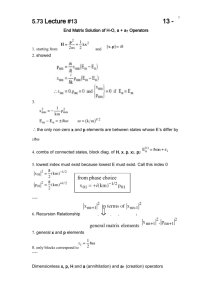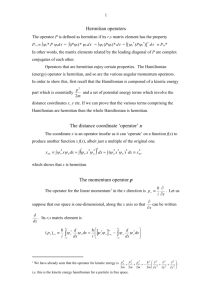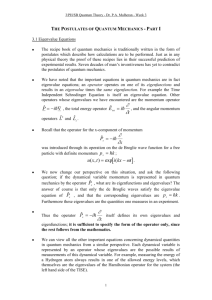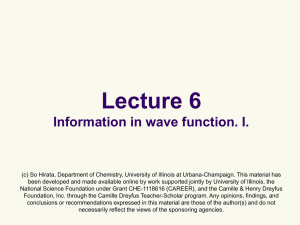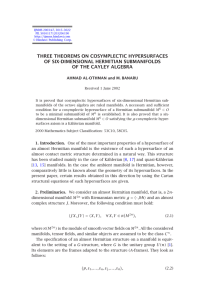Feature Selection/Extraction for Classification Problems
advertisement
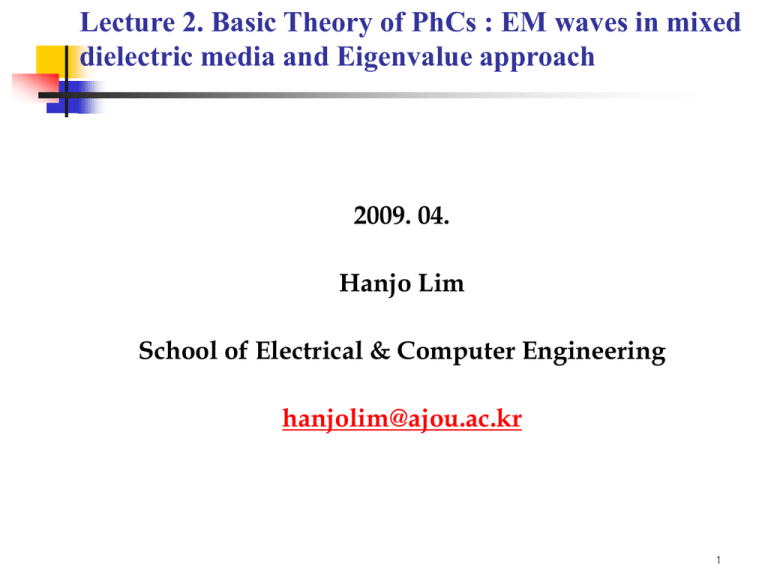
Lecture 2. Basic Theory of PhCs : EM waves in mixed dielectric media and Eigenvalue approach 2009. 04. Hanjo Lim School of Electrical & Computer Engineering hanjolim@ajou.ac.kr 1 Maxwell equations are given as; D 4 , 1 B E 0 c t B 0, 4 1 D H J 0 c c t in cgs units . Constitutive relations ; relations between D & E , B & H , J & E , etc D i ij E j k ijk E j E k O ( E ) if linear , isotropic , and lossless media j j D ( r ) ( r ) E ( r ) or D ( r , ) ( r , ) E ( r , ) B ( r ) ( r ) H ( r ) 1 in optical freq. range for most materials B (r ) H (r ) and especially for dielectric materials. 3 ∴ Maxwell equations are given as; (r ) E (r , t ) 0, H (r ,t) 0 , 1 H (r , t ) E (r , t ) 0 c t (r ) E (r ,t) H (r ,t) 0 c t 2 E and H Then ; complicated functions of time and space. But Maxwell eqs. are linear => time dependence can be expressed by harmonic modes. i t i t H ( r ,t ) H ( r ) e , E ( r ,t ) E ( r ) e Then mode profiles of a given frequency are given from Maxwell equations. H ( r ) 0 , D ( r ) 0 ; Nonexistence of source or sink Field configurations are build up of transverse EM waves. Transversality : If H ( r ) a exp( i k r ), a k 0 i 1 H (r ,t) E (r ,t) 0 E (r ) H (r ) 0 c t c (r ) E (r , t ) i H (r , t ) 0 H (r ) (r )E (r ) 0 c t c 3 Take main function as magnetic field H ( r , t ) i i E (r ) 0 E (r ) H (r ) (r ) c c 2 1 H ( r ) H ( r ) ; Master equation (r ) c Master eq. with H ( r ) 0 condition completely determines H (r ) * Schrodinger equation : 2 2 V (r ) (r ) E (r ) 2m : eigenfunction (r ) eigenvalue problem => eigenvalue E and For a given photonic crystal (r ), master equation => eigen modes. c H (r ) If modes H ( r , ) for a given are known , E ( r ) i ( r ) 4 Interpretation of Master equation ; Eigenvalue problem 2 1 H (r ) H (r ) (r ) c operator eigenvalue eigenvector if 2 H ( r ) H ( r ) c with operation on H (r ) => eigenvectors H (r ) ; field H (r ) is allowed. 1 H (r ) H (r ) ( r ) H (r ) 2 / c & eigenvalue eigenvector patterns of the harmonic modes. Note) operator ; linear operator wave eq.; linear differential eq. ∴ If H 1 ( r ) and H 2 ( r )are two different solutions of the eq. with same , 2 general solution of H ( r ) / c H ( r ) ; H ( r ) H 1 ( r ) H 2 ( r ) 5 ∴ Two field patterns that differ only by a multiplier ; same mode. Hermitian property of 1 (r ) def) inner product of two vector fields * * Note that ( F , G ) ( G , F ) * . ( F , G ) F ( r ) G ( r ) dv d r F ( r ) G ( r ), * * * * * Proof :( F , G ) d r F ( r ) G ( r ) F ( r ) G ( r ) G ( r ) F ( r ) G ( r ) F ( r ) * * * dr G (r ) F (r ) G , F * 2 Note that ( F , F ) d r F ( r ) F ( r ) d r F ( r ) ; always real If ( F , F ) 1 ; called normalized mode, Normalization of F with ( F , F ) 1 def) Hermitian matrix (self-adjoint) Aij A ji , if * adjoint Aij Aij A ji * Hermitian 6 def) Hermitian operator Q a Q b dv Q a b dv * * * Properties) 1. If operator Q is Hermitian for arbitrary normalizable functions . 2 3 Q , Q , ... are Hermitian. a Q b dv Q a Q b dv ( Q a ) b dv * 2 * * 2 * Q ; Hermitian 2 2. A linear combination of Hermitian operators is a Hermitian operator. 3. The eigenvalues of a Hermitian operator are all real. * * * Proof; Let Q n q n n . n Q n dv n q n n dv q n n n dv * * * * If Hermitian operator ( Q n ) n dv ( q n n ) n dv q n n n dv q n q n q n ; real * 4. Any operator associated with a physically measurable quantity is Hermitian (postulate). 7 def) Hermitian operator for vector fields F (r ) and G (r ) * * If ( F , G ) ( G , F ), i.e., d r F G d r ( F ) G , that is, the inner product of –operated field is independent of which function is operated, : Hermitian operator. 1 Proof of ( r ) is Hermitian operator. * 1 * * * ( F , G ) dv F G ( F ) F F (r ) let * * dv ( F ) dv ( F ) divergence theorem dv a n ds v 1 * * dv G F ( r ) v s 1 * G F a n ds 0 (r ) s 8 Note ;F &G 1) zeros at large distances due to 1 / r 2 , 1 / r 3 dependence 2) periodic fields in the region of integr. (∵ harmonics) * 1 1 * ( F , G ) dv G ( F ) dv ( F ) G (r ) (r ) 1 * 1 * 1 * ( F ) G G F ( F ) ( G ) (r ) (r ) (r ) * * 1 1 F G ( F ) ( G ) (r ) (r ) * After integration, * 1 1 dv ( F ) G dv F G ( F , G ) (r ) (r ) 1 is a Hermitian (r ) operator 9 Note * 1 * 1 1 ; ( F ) G G F ( F ) * G (r ) (r ) (r ) * 1 * 1 * 1 G F G ( F ) G F (r ) (r ) (r ) 1 1 1 since is not a constant. G G (r ) (r ) (r ) General properties of harmonic modes 2 2 1) Hermitian operator H ( r ) H ( r ), eigenvalue must be real. c c 2 2 * Proof)( H , H ) ( H , H ) d r H ( r ) H ( r ) c c * * * 2 * 2 ( H , H ) 2 ( H , H ) 2 ( H , H ) c c Note that ( H , H ) ( H , H ) * for any operator 10 * * * * * * Proof) ( H , H ) d r ( H ) H d r ( H ) H d r H H * * d r H H ( H , H ) ( H , H ) ( H , H ) 2 Hermitian operator ; ( H , H ) ( H , H ) ( / c ) ( H , H ) * * * 2 2 * * 2 2 Then ( H , H ) ( / c ) ( H , H ), ( H , H ) ( H , H ) ( H , H ) ( H , H ) ( / c )( H , H ) Hermitian operator for any operator ( / c )( H , H ) 2 ( / c ) ( / c ) , i.e , 2 2 * 2 2 2 2* 2 2 ; real Note) ; 2 is actually positive => ; real . If becomes imaginary in some frequency range, what dose it mean? Proof) * * 1 1 From ( F , G ) d r F G d r ( F ) G Let F G H (r ) (r ) 11 * 1 1 Then ( H , H ) d r ( H ) ( r ) ( H ) d r ( r ) H 2 ( / c ) ( H , H ) positive ( / c ) 2 2 positive positive ; positive ; positive 2 ; real If (r ) is negative in some frequency range, ; imaginary. Meaning? 2) Operator is Hermitian means that H 1 ( r ) and H 2 ( r ) with different frequencies 1 and are orthogonal. 2 2 Proof) let H 1 ( r , 1 ), H 2 ( r , 2 ), than H 1 ( r ) ( 1 / c ) H 1 ( r ), H 2 ( r ) ( 2 / c ) H 2 ( r ). Hermitian ; ( H 2 , H 1 ) ( H 2 , H 1 ) 2 2 2 2 ( H 2 , H 1 ) c ( H 2 , H 1 ) c ( H 2 , H 1 ) 2 ( H 2 , H 1 ) 2 2 ( 1 2 )( H 2 , H 1 ) 0 if 1 2 , ( H 2 , H 1 ) 0 2 1 12 Orthogonality & modes Meaning of orthogonality of the scalar functions => normal modes. Meaning of orthogonal vector fields : ( F , G ) 0 Meaning of orthogonal vector modes. Degeneracy : related to the rotational symmetry of the modes. Electromagnetic energy & variational principle => qualitative features Def) EM energy functional E f ( H ) ( H , H ) / 2 ( H , H ), 2 E f ( H ) ( / c ) ( H , H ) / 2 ( H , H ) if H (r ) is a normal mode. The EM modes are distributed so that the field pattern minimizes the EM energy functional E f Proof) When H ( r ) H ( r ) H , E f E f ( H H ) E f ( H ) ; 0 13 1 ( H H , H H ) 1 ( H , H ) , E f (H ) E f ( H , H ) 2 ( H H , H H ) 2 (H ,H ) * ( H H , H H ) dv (H H ) ( H H ) ( H , H ) 0 1 ( H , H ) ( H , H ) ( H , H ) ( H , H ) ( H , H ) let 2 ( H , H ) 2 ( H , H ) ( H , H ) ( H , H ) Hermitian 1 2 ( H , H ) 1 ( H , H ) 2 ( H , H ) 2 ( H , H ) 1 1 2 2 ( H , H ) (H ,H ) (H ,H ) ( H , H ) 1 ( H , H ) Binomial (or Tayler) expansion ( H , H ) ( H , H )( H , H ) ( H , H ) 2 ( H , H ) 2 ( H , H ) 4 1 (H ,H ) (H ,H ) 2 (H ,H ) 14 ( H , H )( H , H ) ( H , H ) (H ,H ) E f E f ( H H ) E f ( H ) (H ,H ) If E f ( H ) 1 ( H , H ) H H H (H ,H ) (H ,H ) H is an eigenvector of with an eigenvalue ( H , H ) H H (H ,H ) E f 0 2 of 2 , H H . c c : stationary with respect to the variations of H when H is a harmonic mode H0 Lowest EM eigenmode ; minimizes E f . Then next lowest EM eigenmode H 1 ; minimizes E f in the subspace orthogonal to H 0 , etc. 15 Another property of variational theorem on EM energy functional ) 1 ( H, H , ( H , H ) E f (H ) 2 (H , H ) v Ef * 1 dv H H ( A B ) B A A B (r ) 1 * * 1 ( H , H ) dv ( H ) H dv ( H ) ( H ) ( r ) ( r ) v v * * 1 1 ( H ) H a n ds dv ( H ) ( H ) (r ) (r ) s v (why?) 1 1 dv H Ef (r ) 2( H , H ) 1 1 dv D (r ) c 2( H ,H ) 2 i i H (r ) E (r ) D (r ) c c 2 E f is minimized when the displacement field D regions of high dielectric constant (due to 1 / ( r ) is concentrated in the with continuous D n ). 16 Physical energies stored in the electric and magnetic fields ED Harmonic 2 1 D ( r ) dv , 8 ( r ) magnetic field H (r ), 1 EH 1 8 2 H ( r ) dv electric field D (r ) 2 1 Our approach ; master eq. H ( r ) H ( r ) with c (r ) 1 D i ic ( r ) E ( r ), and E ( r ) then H ( r ) H ( r ) c t c ( r ) Question ; Can we make up another master eq. for D ( r ) E ( r ), and i ic then calculate H (r ) from E ( r ) H ( r ) or H ( r ) E ( r ) ? c 1 H i i 2 H , E (r ) H (r ) D (r ) From E ( r ) c t c c c 17 2 1 / ( r ) D ( r ) / c D ( r ) ∴ Master eq. should be with the operator 2 Z 1 / ( r ) and eigenvalue / c . But operator Z is not Hermitian. Proof) * 1 ( F , Z G ) dv F G (r ) ( A B ) B A A B * * 1 1 dv G F dv G F (r ) (r ) * 1 * 1 1 * dv ( F ) G dv G ( F ) dv G ( F ) (r ) (r ) (r ) * * 1 1 ( F , Z G ) dv ( F ) G dv F G ( Z F , G ) (r ) ( r ) Z 1 / ( r ) is not Hermitian. 1 / ( r ) Since is not a constant, 18 1 If we take D (r ) 2 to Z 1 D ( / c ) Z 2 D D, 2 1 1 1 instead of D D is equivalent (r ) (r ) c (r ) 1 1 1 with Z 1 ( r ) ( r ) and Z 2 . Even if Z 1 , Z 2 ; (r ) Hermitian operators, it is a numerically difficult task to solve. Scaling properties of the Maxwell eqs./Contra. or expansion of PhCs. (r Assume an eigenmode H ( r , ) in a dielectric configuration ), 1 2 then H ( r ) H ( r ). What if we have another (r ) c of dielectric ( r ) r / s with a scalling parameter s? r If we transform as ∴ Let’s transform the configuration then a x a y a z . x y z s position vector r and operator as r r / s , / s . r sr , 19 1 1 Then, ( r ) H ( r ) s ( s r ) s H ( s r ) c But 2 H ( s r ). 2 1 s ( s r ) ( r ) H ( s r ) H ( s r ). ( r ) c This is just another master eq. with H ( r ) H ( s r ) and s . ( r ) Likewise if dielectric constant is changed by factor of s 2 as ( r ) 2 , s 2 2 1 s H ( r ) . 1 H ( r ) 2 H ( r ) H ( r ). ( r ) c c s (r ) ∴ Harmonic modes of the new system are unchanged but the mode frequencies are changed so that s Electrodynamics in PhCs and Quantum Mechanics in Solids 20

